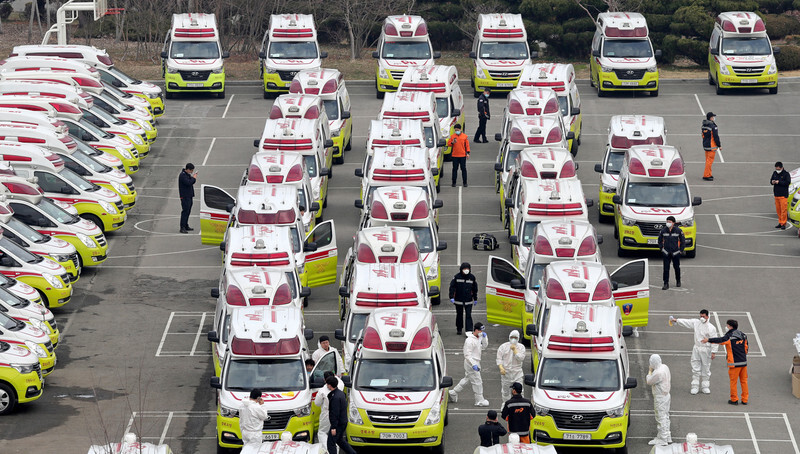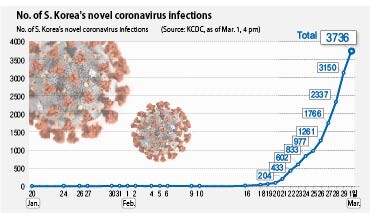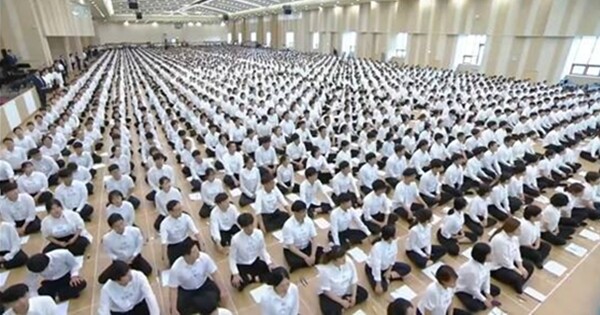hankyoreh
Links to other country sites 다른 나라 사이트 링크
[News analysis] The reasons why transmission is so prevalent among Shincheonji members

Around 40 days after the first confirmed case of novel coronavirus infection in South Korea, there are now more than 4,000 cases in the country, and the number of new patients connected with the Daegu branch of the Shincheonji religious sect continues to climb. The public health authorities think “atypical transmission” occurred at the church and expect that the beginning of March, which represents two weeks after the Feb. 16 service was held there, will be a turning point in the spread of the disease.
According to figures released by South Korea’s Centers for Disease Control and Prevention (KCDC), 476 new cases were confirmed as of midnight of Mar. 2, bringing the total to 4,212. The vast majority of the new cases, or 445, occurred in Daegu. More than half of all cases in South Korea are connected with the Shincheonji religious sect. As of Monday, more 2,418 confirmed cases around the country were linked to the church.

One notable phenomenon is the high percentage of believers at Shincheonji’s Daegu branch who have tested positive for COVID-19. The public health authorities have also said that the reproduction number (R0, pronounced “R naught”) at the church is “unusually high.” The reproduction number represents the number of people to whom each infected individual transmits the virus. Whereas studies conducted in China and other places have indicated that each patient transmits the virus to two or three people, experts believe that church members have infected from seven to 10 people.
“It’s quite likely that close contact between Shincheonji believers was greater and lasted longer than we’d imagined. We’re continuing to investigate why the COVID-19 transmission was so widespread among Shincheonji believers, since that information could be important for blocking [transmission] down the road,” said Kwon Jun-wook, a KCDC official.
Several analyses have been made about the close physical interaction that takes place at Shincheonji services and among its believers outside of services. “Shincheonji believers meet together in confined spaces not only on Sunday but also on weekdays. Their services last three hours, which is longer than other religious groups, and they frequently say amen during sermons and sing hymns, increasing the risk of droplet infection,” said Lim Ung-gi, a pastor who directs the Gwangju branch of the Korean Christian Cult Counseling Center.

Shincheonji has cells and secret groups that operate separately from its public services
“Another apparent cause of transmission is that [Shincheonji] has cell groups and secret groups that operate separately from its public services,” said Han Seung-hun, a scholar of religious sociology and a drama lecturer at the Korea National University of Arts.
Medical professionals have raised a variety of possibilities about the unexpected speed with which the disease has spread. “It’s believed that a Shincheonji member was infected in the first week of February, and that the second, third, and fourth generations of transmission occurred over the following three weeks,” said Oh Myeong-don, chair of the New Infectious Disease Central Clinical Committee. According to Oh, the current state of transmission is inexplicable unless a large number of believers had already been infected before the 31st patient tested positive and that they’d already passed the disease on to a significant number of believers before the service on Feb. 16.
“The potential for mass exposure at the Bible studies and other meetings held frequently in the organization seems to have had an impact,” said Lee Jae-gap, a professor of infectious disease at the College of Medicine at Hallym University.
“The problem seems to have been that [an infected person] was admitted initially and repeatedly came into contact with large numbers of people who were unaware [of the infection],” said Choe Won-seok, a professor of infectious disease at Korea University Ansan Hospital.
All 239,000 Shincheonji members surveyed about symptomsAccording to sources at the city of Daegu and South Korea’s Central Disaster and Safety Countermeasures Headquarters, all 9,334 members of Shincheonji’s Daegu church are being treated as suspected patients and have been placed under self-quarantine, where they are being tested during home calls. As of Feb. 28, Daegu had completed testing 3,293 of these individuals.
In addition, all 239,000 Sincheonji members are being surveyed about whether they have symptoms, with the survey 95% complete. In areas outside of Daegu, 8,563 church members and 383 trainees have been categorized as suspected patients and are being tested by their respective local governments. The health authorities are working with the police to ascertain the whereabouts of some 4,000 believers in the country who have yet to be surveyed.
Given the possibility of symptoms occurring as part of a second wave of infections at the end of the maximum two-week incubation period following the Daegu service on Feb. 16, the public health authorities believe that early March will be a watershed that will indicate whether the disease will spread further. But they aren’t ruling out the possibility of the disease spreading to small groups or communities outside of Shincheonji’s Daegu branch and plan to continue monitoring places with a high risk of additional transmission, including hospitals, nursing homes, social welfare facilities and schools. More specifically, they added that they’ll be keeping an eye on places and environments in which contact can occur for more than 15 minutes at a radius of 2m.
“At the moment, we believe that there’s every possibility of containing and controlling the spread of the disease going forward, as long as people strictly maintain social distance and abide by personal hygiene rules,” Kwon said.
Shincheonji members visited Wuhan sometime in JanuaryDuring the daily briefing on Mar. 1, Kwon added that “after reviewing the travel records of Shincheonji believers with the help of the Justice Ministry, we’ve determined that some of them visited the Chinese city of Wuhan in January.”
“Considering that the first domestic case occurred on Jan. 20 and that the disease has been spreading since February, we’re working backward to figure out the number of Shincheonji believers who’ve been to China since January. That information might be useful for helping us determine how COVID-19 spread so widely among Shincheonji believers,” Kwon said. The KCDC didn’t disclose how many believers visited Wuhan in January, however.
The Justice Ministry announced on Feb. 29 that, according to its tentative calculations, 42 Shincheonji believers had entered South Korea from Wuhan over the past eight months. The Ministry compiled the travel records of all 244,743 Shincheonji members over the past eight months (from July 2019 until Feb. 27, 2020) at the request of the KCDC. During that period, 3,610 members entered South Korea from China, with 42 of them arriving from Wuhan, the Justice Ministry said.
By Park Da-hae, Seon Dam-eun, and Kang Jae-gu, staff reporters
Please direct comments or questions to [english@hani.co.kr]

Editorial・opinion
![[Editorial] Intensifying US-China rivalry means Seoul must address uncertainty with Beijing sooner than later [Editorial] Intensifying US-China rivalry means Seoul must address uncertainty with Beijing sooner than later](https://flexible.img.hani.co.kr/flexible/normal/500/300/imgdb/original/2024/0517/8117159322045222.jpg) [Editorial] Intensifying US-China rivalry means Seoul must address uncertainty with Beijing sooner than later
[Editorial] Intensifying US-China rivalry means Seoul must address uncertainty with Beijing sooner than later![[Column] When ‘fairness’ means hate and violence [Column] When ‘fairness’ means hate and violence](https://flexible.img.hani.co.kr/flexible/normal/500/300/imgdb/original/2024/0516/7417158465908824.jpg) [Column] When ‘fairness’ means hate and violence
[Column] When ‘fairness’ means hate and violence- [Editorial] Yoon must stop abusing authority to shield himself from investigation
- [Column] US troop withdrawal from Korea could be the Acheson Line all over
- [Column] How to win back readers who’ve turned to YouTube for news
- [Column] Welcome to the president’s pity party
- [Editorial] Korea must respond firmly to Japan’s attempt to usurp Line
- [Editorial] Transfers of prosecutors investigating Korea’s first lady send chilling message
- [Column] Will Seoul’s ties with Moscow really recover on their own?
- [Column] Samsung’s ‘lost decade’ and Lee Jae-yong’s mismatched chopsticks
Most viewed articles
- 1Celine Song says she’s gratified global audiences have responded to the kismet of ‘inyeon’
- 2[Editorial] Transfers of prosecutors investigating Korea’s first lady send chilling message
- 3[Exclusive] Unearthed memo suggests Gwangju Uprising missing may have been cremated
- 4[Column] US troop withdrawal from Korea could be the Acheson Line all over
- 5Truth commission confirms Korean War killings by soldiers and police
- 6USFK sprayed defoliant from 1955 to 1995, new testimony suggests
- 7[Editorial] South Korean women are mobilizing in unprecedented ways
- 8Calls for gender-equality continue as demonstrations target President Moon
- 9[Column] “Hoesik” as ritual of hierarchical obedience
- 10Why Kim Jong-un is scrapping the term ‘Day of the Sun’ and toning down fanfare for predecessors